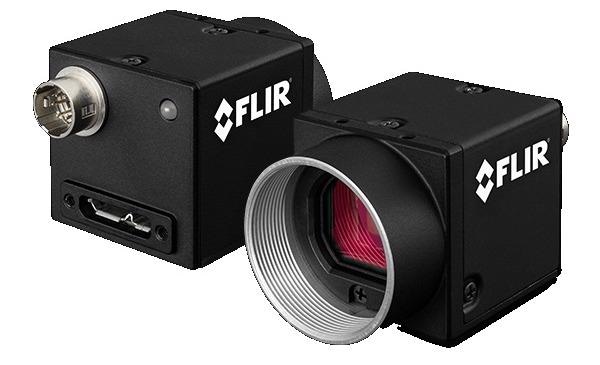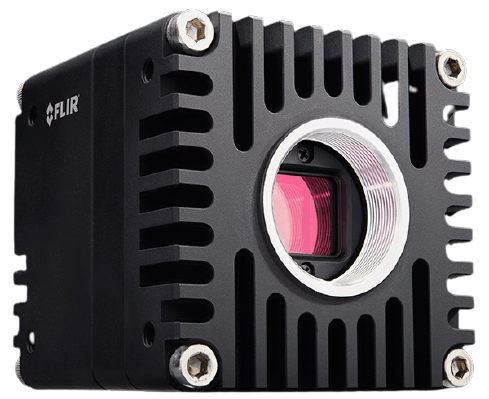
Image Credit: FLIR Systems
Complementary metal-oxide-semiconductor (CMOS) technology now supplies the advanced imaging capabilities needed for a number of biomedical applications and this article will explore whether it can replace the more expensive sCMOS (scientific CMOS) sensors.
The benchmark has been set for both value and performance in machine vision in numerous industries by CMOS and sCMOS sensors. The costs and advantages of each technology for highly demanding imaging applications in life sciences and biomedical is outlined below.
What is the Difference Between CMOS and sCMOS Sensors?
Generally, a sCMOS sensor is thought of as a “next-generation” CMOS sensor. During the early phases of CMOS development, sCMOS technology was introduced to bridge the gap between new CMOS sensors and traditional CCD (Charge Coupling Device) sensors.
At first biomedical applications were unable to utilize CMOS sensors because of the compromises in read noise, dynamic range, frame rates and resolutions.
When sCMOS cameras were first introduced, they employed very similar design principles and fabrication methods as CMOS sensors, but incorporated a number of features that helped them to overcome the initial shortcomings of CMOS.
This made sCMOS sensors ideal for scientific applications where wide dynamic range, low light performance, and high fidelity were crucial.
Conventional CMOS sensors have significantly improved in terms of their quantum efficiency and the ability to decrease their own internal noise. In the years since sCMOS cameras were introduced, making CMOS cameras a viable choice for many advanced biomedical applications.
Most CMOS cameras are also significantly cheaper than sCMOS cameras. This factor alone has motivated many engineers and researchers to think about assessing the latest CMOS sensor when they need to select a histology camera, microscopy camera, cytology/cytogenetics camera, or epifluorescence camera for their application.
CMOS or a sCMOS Sensor?
Whether to choose a CMOS or sCMOS sensor depends on a range of factors. A user is likely using epifluorescence illumination if they are debating between the two as white light is bright enough that a sCMOS sensor is not needed.
The suitability of one over the other can be as simple as how much light is getting to the camera, or a combination of performance parameters that are unique to a specific application.
Regardless of CMOS or sCMOS, a monochrome sensor should be selected over a color equivalent for the inherent quantum efficiency advantage supplied by a monochrome sensor.
A sCMOS sensor is characterized by large pixels and backside illumination, helping to decrease overall noise (like CCD technology). sCMOS cameras also usually include a Peltier cooling system to decrease thermally produced noise over long exposures.
Cameras using sCMOS sensors also require a high bandwidth interface like CameraLink or CoaXpress with a frame grabber board which makes vision systems such as these more complex and so more costly.
CMOS manufacturers have continued making significant improvements to counter this. These improvements have been made in reducing read noise (ensuring even low levels of incoming photons are not lost within this noise), quantum efficiency (the ability to collect incoming photons), and implementing backside illumination.
Although Peltier cooling is also a choice with some CMOS sensors, the reduced noise and enhancements to quantum efficiency have made cooling unnecessary for some biomedical imaging applications.
The interface is a further way cost is kept down. For years, CMOS sensors have been paired with consumer interfaces such as GigE, USB3, and 10 GigE. These interfaces do not need a frame grabber, which decreases the complexity (and cost) of the system.
By supplying much higher bandwidths, upcoming interfaces such as 25/100 GigE, USB4, and CXPX will help to eliminate this problem entirely.
CMOS Sensors are a Lower-Cost Alternative
The lower cost alone has motivated many engineers and system designers to consider assessing the latest CMOS sensors in place of an sCMOS based system.
In a number of instances, vision system designers are surprised to find a suitable CMOS camera for less than USD $1,000, when a typical sCMOS setup with similar performance parameters could cost more than USD $10,000.
Most camera manufacturers do not utilize a single standard to compare cameras, whether it's sCMOS or CMOS so it can be difficult to compare cameras regardless of the type of sensor employed.
For specifications and measurement of cameras in Europe, Japan (JIIA - Japan Industrial Imaging Association), and America (AIA - American Automated Imaging Association) in the machine vision world, EMVA1288 has become the accepted standard.
So, a sCMOS camera might be a necessity for applications that require extreme levels of performance, but it would be worthwhile to identify the key performance parameters for a specific application and make a fair comparison between CMOS and sCMOS cameras before selecting one over another.
The price-to-performance ratios between CMOS and sCMOS are narrowing quickly and CMOS sensors are continuously advancing. It might be a much less expensive alternative if application requirements can be met by a conventional CMOS sensor.
Choosing a FLIR CMOS Machine Vision Camera
If a CMOS camera is chosen for an application, the two most popular FLIR camera families for epifluorescence applications include the Oryx and Backfly S.
The Oryx camera family provides the fast 10 GigE interface paired with high resolution sensors. Oryx cameras are full-featured and suitable for higher end applications but have a larger form factor. Oryx will be an easy choice if transfer speeds are vital.
The Blackfly S camera family provides the widest range of interfaces and sensors, both USB3 and GigE. There is also a large variety of sensor options coupled with both a cased and board-level form factors.

Image Credit: FLIR Systems
Both the Blackfly S and Oryx camera families can be controlled and programmed by utilizing GenICam3 and the Spinnaker SDK, which has been designed to help a user build their application more quickly.

Image Credit: FLIR Systems
To narrow down the selection of camera models further, the machine vision model selector from FLIR includes 14+ (EMVA 1288 based) imaging parameters to filter from. Filter on finding high absolute sensitivity, quantum efficiency, and dynamic range values to find models which work well under low light conditions.

This information has been sourced, reviewed and adapted from materials provided by FLIR Systems.
For more information on this source, please visit FLIR Systems.